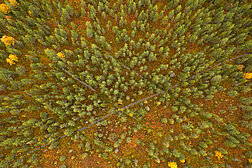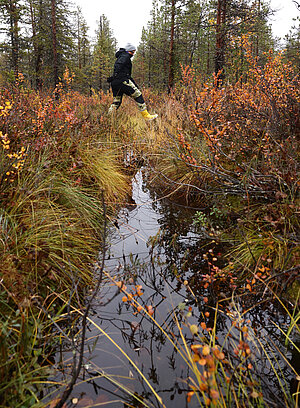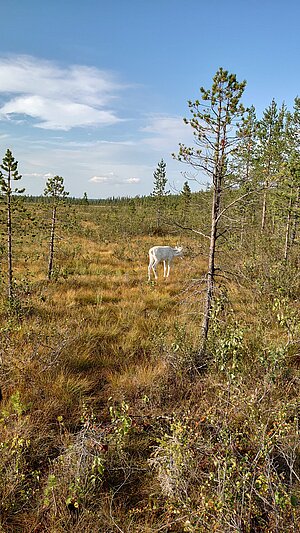Matorovansuo peatland is located in Northern Finland in a valley between two fairly large upland hill formations, Matorova and Aittavaara-Lusmavaara. Ground and surface waters from the eastern slope of Matorova and southern slopes of Aittavaara and Lusmavaara drain to Matorovansuo and thus primarily define the hydrology of the Matorovansuo peatland. Waters from the peatland drain south to Kivijärvi and further to river Ounasjoki. This groundwater-fed mire has a mosaic structure of wet open sedge fens, typical of northern aapa mires, and patches of thin-peated treed pine-sedge fens and some mineral soil islands. A small stream runs through the peatland, and its riparian zones are also treed as well as the transitional zones of the mire margins close to the upland edges. The wet sedge fen parts are patterned with shrubby strings and oligo-mesotrophic wet flarks dominated by brown mosses and some Sphagnum species. The wooded parts are characterized by shrubby forest moss hummocks, and Sphagnum-dominated ground vegetation together with dwarf shrubs, especially Betula nana, prevails between the hummocks.
Drainage for forestry of the treed parts (ca. 60% of the mire area) was conducted probably in the late 1960’s or 1970’s (exact time not known). Ditching did not extend to the wet open parts of the mire. The hydrological status of the sedge fens has, however, also changed as the entire peatland was surrounded by ditches in order to cut the surface water flow from the uplands. The impact of the drainage on tree growth has been very modest, obviously due to the harsh subarctic climate and short growing seasons. The most evident changes in the vegetation structure of the pine mires involve increased abundance of dwarf shrubs, especially Betula nana, and decreased abundance of tall sedges, such as Carex lasiocarpa.
Välisuo is a narrow, south-north oriented groundwater-fed sedge fen located on the western slope of Matorova-Kenttärova upland hill formation located in Northern Finland. Waters from Välisuo Mire drains partly north directly to lake Pallasjärvi and partly south and west via ditches to a small stream running through another peatland, Lompolojänkkä, and further to lake Pallasjärvi. Välisuo has a fairly flat surface patterning and is characterized by mesotrophic vegetation in the wetter parts and oligotrophic, sedge-dominated vegetation in the drier parts close to the water divide. Mire margins on both eastern and western sides are partly treed sedge pine fens. Drainage for forestry in the treed parts of the mire (ca. 10% of the mire area) was conducted in late 1960’s or 1970’s (exact time not known). Ditches dug to cut surface water flow from the uplands surround the entire mire and thus have had some impact on the hydrology of also the undrained parts of the mire.

 CONFERENCE
CONFERENCE

